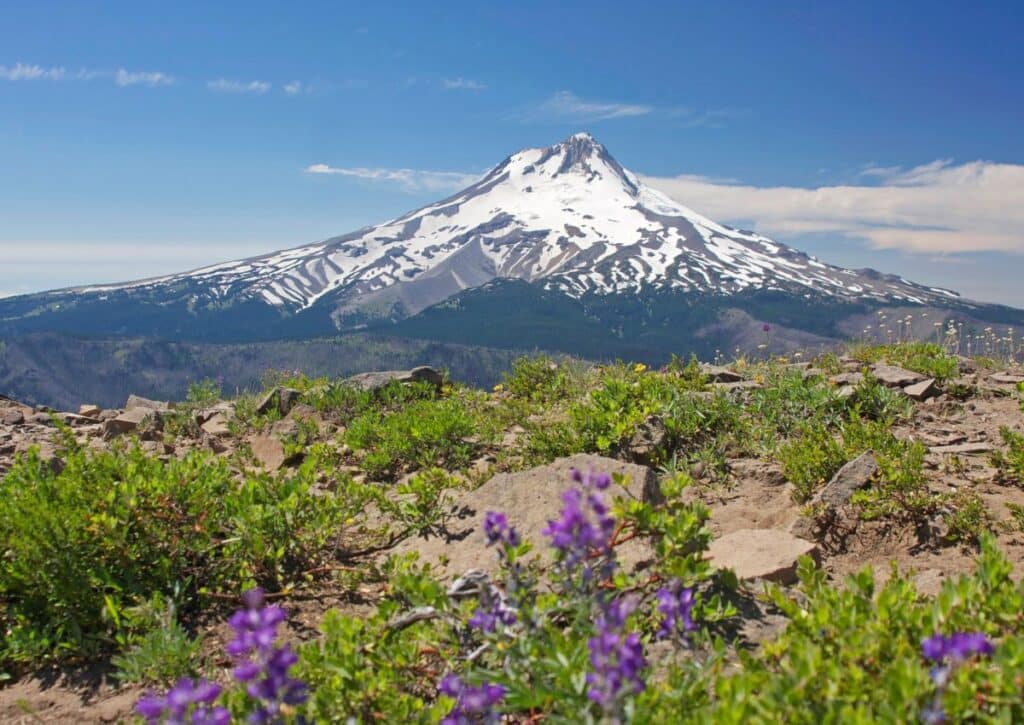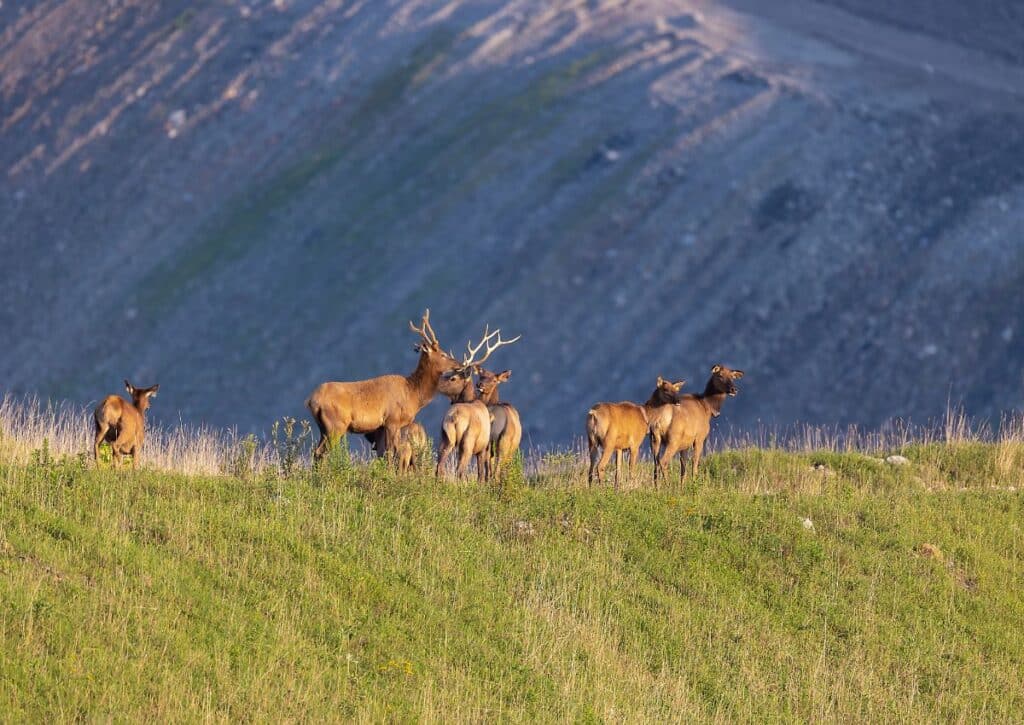Explore the top 7 National Forests in Oregon for hiking, wildlife, and camping adventures.
Oregon, with its breathtaking landscapes and diverse terrain, is home to some of the nation’s most enchanting national forests.
From the snow-capped peaks of Mount Hood to the serene trails of the Umpqua, each forest offers a unique blend of natural wonders and outdoor adventures.
If you’re plotting your next journey and have Oregon’s woodlands on your radar, you’re in for a treat.
Whether you’re an avid hiker, a birdwatcher, or someone looking for a tranquil spot to set up camp, a corner in Oregon’s vast forests is waiting for you.
This guide will delve deep into the heart of these forests, spotlighting the wildlife, hiking trails, and campgrounds that make each one special.
So, as you plan your trip, let’s explore together and find the perfect national forest (or forests!) for your Oregon adventure.
Deschutes National Forest
Nestled in the heart of Central Oregon, Deschutes National Forest stands as a testament to nature’s grandeur.
Spanning a vast 1.8 million acres, this forest boasts an astonishing mix of landscapes, from towering volcanoes like South Sister to shimmering lakes and rivers like the renowned Deschutes River.
Its name, derived from the French word for “falls,” alludes to the numerous cascading waterfalls that dot its expanse.
The forest’s accessibility from towns like Bend ensures that visitors can effortlessly transition from urban amenities to pristine wilderness in a matter of minutes.
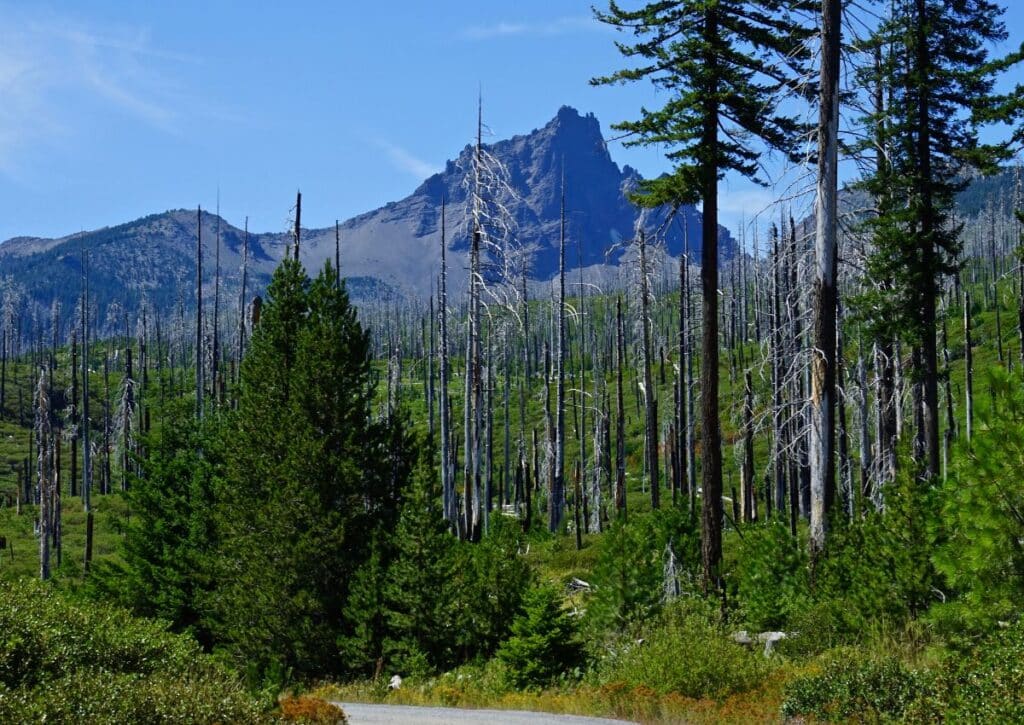
With its combination of scenic vistas, diverse ecosystems, and year-round recreational activities – be it skiing in the winter or paddleboarding in the summer – Deschutes National Forest is more than just a travel destination; it’s an experience, a blend of serenity and adventure that beckons travelers from near and far.
As you embark on your journey to uncover its many secrets, remember that each trail, viewpoint, and campsite tells a story of the land’s rich history and vibrant present.
Wildlife in Deschutes National Forest
Deschutes National Forest is a haven for wildlife enthusiasts. From the smallest insects to the majestic mule deer, the forest pulses with life.
Mammals:
Mule Deer: These graceful creatures are commonly seen in meadows and along the edges of forests. The Metolius Windigo Trail and the Lava River Cave area are good spots to catch a glimpse.
Elk: Early morning or late evening are prime times to spot these large mammals. The Tumalo Falls area is known for occasional elk sightings.
Black Bears: While bears are more elusive, they can be seen in remote areas of the forest, especially near berry patches in late summer. Always view from a safe distance!
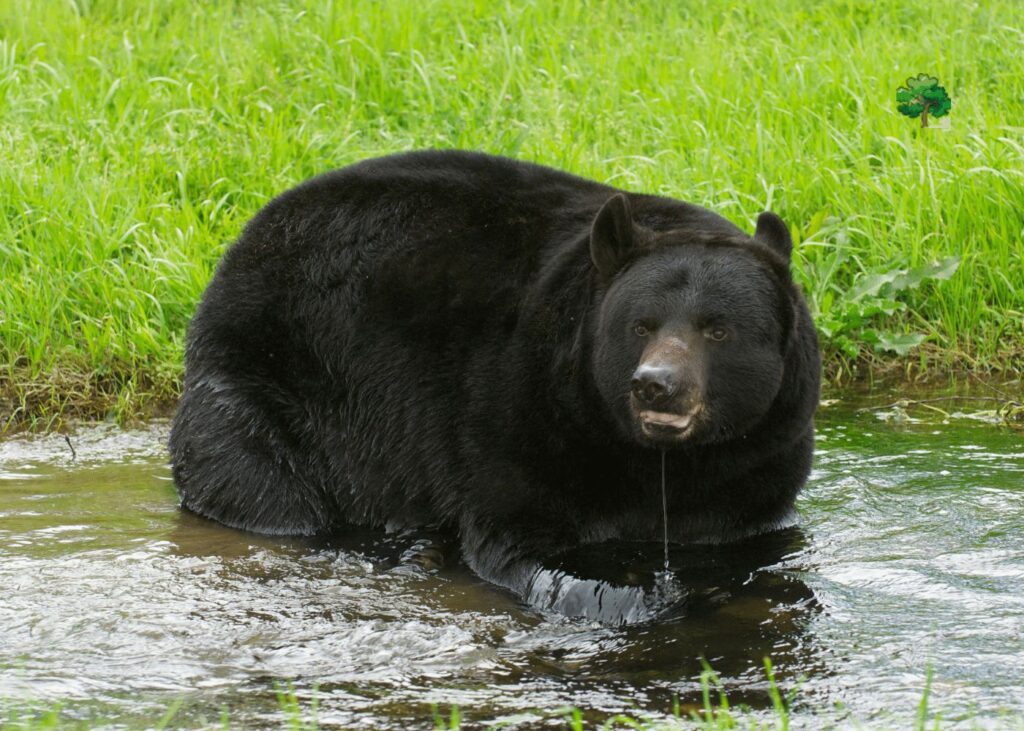
Birds:
Northern Spotted Owl: A symbol of Pacific Northwest forests, spotting one requires patience. The dense, old-growth sections of the forest are their preferred habitats.
Bald Eagles: These majestic birds can often be seen soaring above the lakes, especially around Crane Prairie Reservoir.
Mountain Bluebirds: Look for these vibrant birds in open meadows, particularly along the Cascade Lakes Scenic Byway.
Reptiles & Amphibians:
Western Fence Lizards: These sun-loving reptiles can be found basking on rocks, especially along the Phil’s Trail system.
Oregon Spotted Frogs: Wetlands and ponds, like those near Hosmer Lake, are the best places to find this rare amphibian.
Tips for Visitors:
Always keep a respectful distance from wildlife.
If you’re keen on spotting specific animals, consider visiting at dawn or dusk when many are most active.
Stay quiet and move slowly. Quick movements can startle creatures.
Use binoculars for a closer view without disturbing them.
Remember, feeding wildlife is harmful and illegal. Enjoy observing them in their natural behavior.
Discovering the rich tapestry of wildlife in Deschutes National Forest is a rewarding experience. With patience, a keen eye, and respect for nature, you’re bound to encounter some of Oregon’s most fascinating creatures.
Trails in Deschutes National Forest
The magic of Deschutes National Forest unveils itself as you tread its myriad trails, each offering its own narrative and vistas.
Metolius Windigo Trail
One such path is the Metolius Windigo Trail, stretching an impressive 150 miles from the soothing headwaters of the Metolius River in the Camp Sherman area to Windigo Pass near Crescent Lake.
This trail, which caters to both hikers and equestrians, can be a multi-day journey for those yearning for a more immersive experience.
As you navigate through its expanse, the dense forest canopy opens up to alpine meadows and skirts past serene lakes.
The air often carries the distant calls of woodpeckers, and if you’re fortunate and observant, a mule deer or elk might cross your path.
Tumalo Falls Trail
A contrasting experience awaits at the Tumalo Falls Trail. At 7.4 miles round trip, it may not boast the length of the Metolius Windigo, but what it lacks in distance, it compensates with the grandeur of cascading waters.
Originating from the Tumalo Falls Day Use Area, the trail offers hikers a moderately challenging terrain.
With every step, the symphony of rushing waters grows louder, reaching a crescendo at the magnificent Tumalo Falls.
The surrounding region is home to a rich diversity of avian life, and with a keen ear, you can distinguish the calls of numerous bird species.
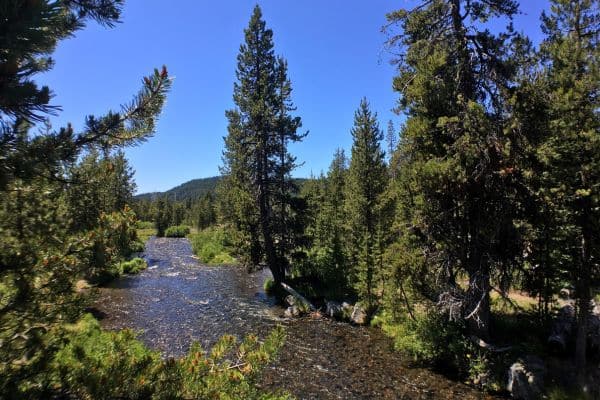
South Sister Summit Trail
For those seeking an elevation challenge, the South Sister Summit Trail is a must-try. The trail, stretching approximately 12.2 miles round trip, commences at Devil’s Lake and winds its way to the summit of the third highest peak in Oregon.
It’s a strenuous hike, but the panoramic views atop are unparalleled. On clear days, one can gaze across Oregon’s vast landscapes, spotting numerous peaks in the horizon.
And as you ascend, keep an eye out for the pikas and marmots, often found amidst the rocky terrains.
Lava River Cave Trail
Another gem, the Lava River Cave Trail, introduces hikers to the subterranean wonders of Deschutes.
Spanning about 2 miles round trip, this easy trail delves deep into Oregon’s longest lava tube. It’s a refreshing change of scene, swapping the forested landscapes for a dark, cool cave environment.
Remember to carry a flashlight or rent a lantern at the entrance. And while the cave’s inhabitants are primarily bats, they’re often elusive, so sightings can be rare but exhilarating.
Green Lakes Trail
Lastly, the Green Lakes Trail, a moderate 8.4-mile hike, starts at the Cascade Lakes Scenic Byway. This trail meanders past gushing waterfalls, through verdant forests, and ends at the pristine shores of the Green Lakes.
The lakes, with their crystal-clear waters, mirror the surrounding peaks, creating picturesque landscapes. The region is a habitat for diverse birdlife and even the occasional beaver or river otter near the water bodies.
Each trail in Deschutes National Forest offers more than just a walk. It’s an experience, a story of nature’s marvels waiting to be discovered.
So, lace up those hiking boots and embark on an adventure through one of Oregon’s most treasured forests.
Camping in Deschutes National Forest
Camping amidst the serene landscapes of Deschutes National Forest is an enchanting experience, a blend of tranquil relaxation and invigorating connection with nature.
With the forest’s diverse terrain, campers can choose from a range of settings, be it by a rippling stream, beneath a canopy of ancient pines, or alongside a sparkling lake.
Every campsite in Deschutes offers a unique gateway to the forest’s wonders, from stargazing beneath clear night skies to waking up to the symphony of birds.
Among the myriad of campgrounds, some stand out for their scenic beauty and amenities:
- Elk Lake Campground: Situated by the stunning Elk Lake, this campground is a paradise for anglers and boaters. With clear waters reflecting the surrounding peaks, it’s a picturesque spot to pitch a tent.
- Crane Prairie Campground: Renowned for its fishing prospects, Crane Prairie Reservoir is home to the Rainbow Trout, known locally as “Cranebows.” The campsites here are spacious, with many right by the water’s edge.
- Lava Lake Campground: Nestled by Lava Lake, this site is a favorite among hikers. With proximity to several trails and the serene lake, it offers a balanced camping experience.
- Tumalo State Park Campground: Located near Bend and the mesmerizing Tumalo Falls, this campground is perfect for those looking to combine wilderness with a touch of urban convenience.
- Little Lava Lake Campground: As the source of the Deschutes River, Little Lava Lake boasts pristine beauty. The campground here is relatively smaller, offering a more intimate experience with nature.
- Sisters Creekside Campground: Just outside the quaint town of Sisters, this site is perfect for those looking to explore both the town’s charm and the forest’s wilderness.
- Big River Campground: Situated along the Deschutes River, it’s an ideal spot for those keen on river activities, from fishing to gentle rafting.
For a more primitive experience, Deschutes also offers dispersed camping. These sites, located outside of designated campgrounds, provide a more secluded and rugged camping experience, allowing visitors to deeply immerse themselves in the wilderness.
It’s essential for campers to be mindful of the forest’s regulations, ensuring they follow Leave No Trace principles. This not only ensures their safety but also the preservation of the forest’s pristine beauty for future generations.
Remember to check seasonal restrictions and campsite availability before heading out, especially during peak seasons when the forest welcomes a large influx of nature enthusiasts.
Camping in Deschutes National Forest is not just about setting up a tent; it’s about creating memories amidst nature’s grandeur, forging a deeper bond with the wilderness, and rejuvenating one’s spirit.
Whether you’re a solo traveler seeking solitude or a family looking for a memorable outing, Deschutes promises a camping experience like no other.
Mount Hood National Forest
Mount Hood National Forest, covering over a million acres, is centered around the iconic Mount Hood, Oregon’s highest peak. This forest is just a short drive from Portland, making it a popular escape for city dwellers.
Renowned for its diverse landscapes, it features alpine meadows, dense forests, and shimmering lakes.
Winter enthusiasts flock to Timberline Lodge for skiing and snowboarding, while summer brings hikers and campers eager to explore over 1,000 miles of trails.
The forest is also dotted with campgrounds, ranging from well-equipped sites with amenities to more secluded spots for primitive camping. For those keen on fishing, the numerous rivers and lakes, teeming with fish, offer ample opportunities.
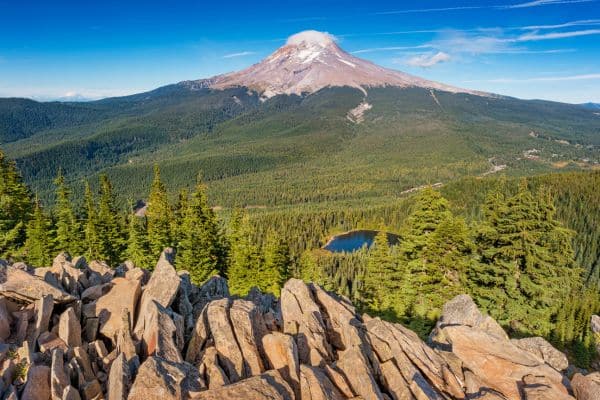
When planning a trip, consider visiting the ranger stations or the forest’s visitor centers—they provide valuable information on current conditions, permits, and recommended spots to explore.
Whether you’re aiming for a day trip or an extended stay, Mount Hood National Forest is a captivating destination, promising a blend of adventure and relaxation.
Wildlife in Mount Hood National Forest
Mount Hood National Forest, a natural sanctuary, teems with wildlife that makes the region uniquely captivating. Knowing where and when to spot these creatures can enhance your forest adventure.
Mammals:
Roosevelt Elk and Black-Tailed Deer: Both are commonly seen during the early mornings and late evenings.
For the best chances, head to clearings and meadows around the Zigzag Mountain area.
These regions offer a good vantage point and are known for regular sightings.
Cougars and Bobcats: While their elusive nature makes sightings rare, the dense woodlands near Ramona Falls Trail have occasional reports.
Remember, it’s always a privilege to spot such creatures, but safety comes first. Read up on wildlife safety tips if you’re hiking in these areas.
Birds:
Birdwatching Hotspots: The wetlands near Trillium Lake are perfect for spotting waterfowl and ospreys.
The old-growth forest regions, especially around Old Salmon River Trail, are where you might hear the haunting calls of the spotted owl or catch a glimpse of woodpeckers.
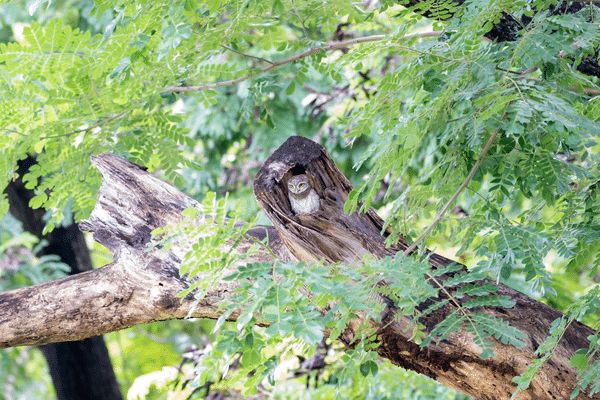
Amphibians and Reptiles:
Rough-Skinned Newts: These are predominantly found around freshwater sources. The ponds along Still Creek Road are known hotspots.
But remember, their bright colors are a warning, so look but don’t touch.
Western Fence Lizards: On a sunny day, the rocks around Burnt Lake offer a good chance of spotting these reptiles sunning themselves.
Practical Tips:
Binoculars Are Your Best Friend: Many animals are best observed from a distance, both for your safety and their comfort.
Visit the Ranger Station: Before heading into the forest, a stop at the Mount Hood Information Center can provide the latest information on wildlife movements or sightings.
Stay Quiet and Observant: Many animals are easily spooked by loud noises. Treading softly can increase your chances of a sighting.
Respect All Wildlife: Keep a safe distance and never feed wild animals. It’s crucial for their well-being and yours.
To truly immerse yourself in the Mount Hood experience, integrating wildlife watching into your itinerary offers an enriching perspective.
While the thrill of spotting a wild animal is unparalleled, remember that the journey and the serene environment are equally rewarding.
Enjoy your visit, and may nature’s wonders never cease to amaze you in Mount Hood National Forest.
Hiking Trails in Mount Hood National Forest
Mount Hood National Forest offers a captivating hiking experience.
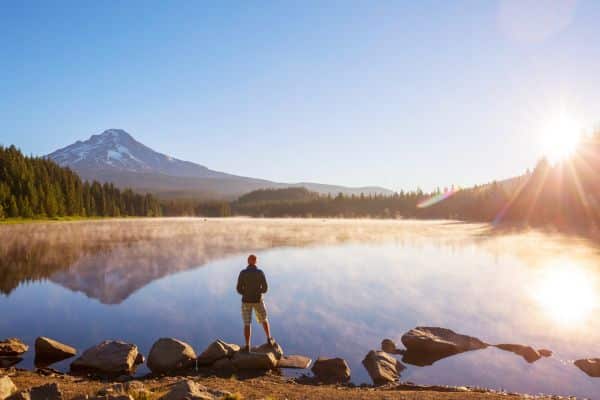
Every path in this forest takes you on a journey of discovery, with each trail revealing a distinct facet of this pristine wilderness.
Timberline Trail
Starting with the renowned Timberline Trail, this approximately 40-mile loop is a challenging endeavor, but the rewards are unparalleled.
As you circumnavigate Mount Hood, you’ll traverse alpine meadows, navigate glacial river crossings, and be treated to expansive views of the Cascade Range.
Given its length and varied terrains, it’s a favorite among seasoned hikers, many of whom break the journey into segments with overnight camping, transforming it into a multi-day adventure.
Ramona Falls Trail
For a blend of forested terrains and a mesmerizing waterfall, the Ramona Falls Trail is a must-visit.
Stretching about 7 miles round trip, the trail is moderately challenging, taking you through dense woods and culminating in the captivating view of Ramona Falls.
The cascading waters create a serene ambiance, ideal for relaxation and photography.
Mirror Lake Trail
Close to Highway 26, the Mirror Lake Trail offers accessibility and charm. This 4.4-mile round trip journey is moderately challenging, leading to the serene Mirror Lake.
On a calm day, the lake beautifully mirrors Mount Hood, creating a picturesque scene.
Ambitious hikers can extend their trek to Tom Dick and Harry Mountain, where the Cascade Range unfurls before them in all its majesty.
Tamanawas Falls Trail
Families and casual hikers find solace in the Tamanawas Falls Trail. This relatively easy, 3.6-mile round trip trek meanders alongside Cold Spring Creek, culminating in the unique Tamanawas Falls.
Here, the water curtain allows for an adventurous walk right behind the cascading falls, offering a refreshing perspective.
Burnt Lake Trail
For those captivated by clear waters and mountain reflections, the Burnt Lake Trail is a delightful choice. At 7.5 miles round trip, it’s a moderate hike leading to the pristine Burnt Lake.
Those seeking an extended adventure can head to Zigzag Mountain, where sweeping vistas await.
Old Salmon River Trail
For a tranquil escape, the Old Salmon River Trail is a haven. This leisurely 5-mile round trip path follows the serene Salmon River, guiding you through ancient forests and offering a peek into the area’s lush greenery and vibrant ecosystem.
Cooper Spur Trail
Lastly, the Cooper Spur Trail is for those who want to challenge themselves. This 6.6-mile round trip trek is not for the faint-hearted.
Beginning at the historic Cloud Cap Inn, the trail ascends steeply, passing through fragrant alpine meadows and culminating in breathtaking views from Cooper Spur’s stone shelter, the closest viewpoint to Mount Hood’s glacier.
When planning a hike in Mount Hood National Forest, always ensure you’re equipped for the trail’s demands.
Weather conditions can change rapidly, so be prepared, and always keep someone informed of your plans.
With adequate preparation, respect for nature, and a keen sense of adventure, the trails of Mount Hood promise an unforgettable trekking experience.
Campgrounds in Mount Hood National Forest
Mount Hood National Forest, with its pristine beauty and diverse landscapes, is a sought-after destination for campers.
From riverside spots to alpine meadows, there’s a campsite to match every camper’s dream. Here’s a look at some of the campgrounds that this forest has to offer.
Trillium Lake Campground is among the most iconic, primarily because of its stunning lake views with Mount Hood as a backdrop.
Just a short drive from Portland, it’s perfect for both short weekend getaways and extended stays.
With canoeing, fishing, and hiking opportunities, it’s a hub of activity during the summer months.
For those seeking river vibes, Riverside Campground offers a serene environment by the banks of the Zigzag River.
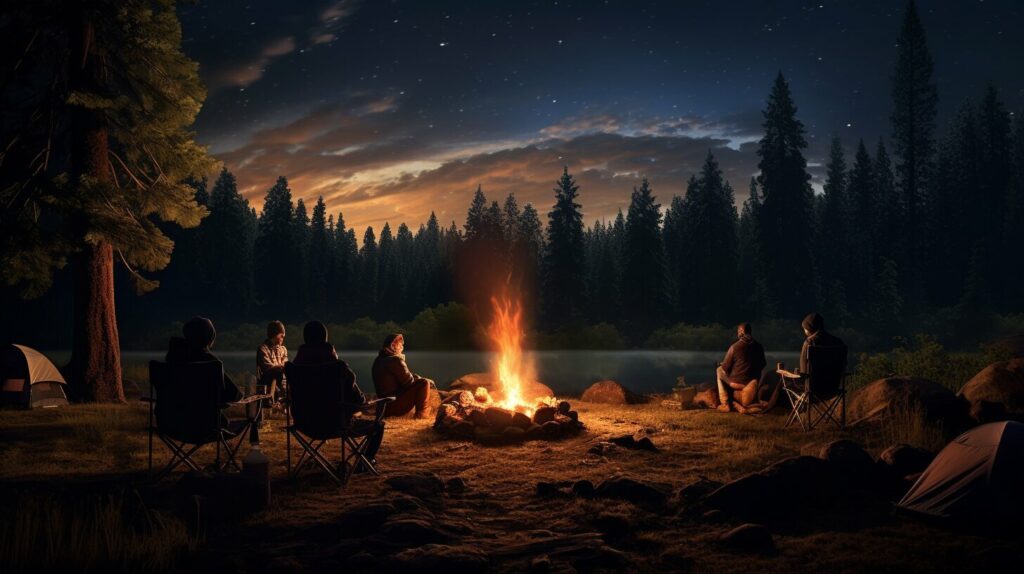
The sound of flowing water combined with the dense canopy makes for a tranquil camping experience, and it’s an excellent base for exploring nearby trails.
Lost Creek Campground is a smaller, more intimate option. Located near Lost Creek, it offers a rustic camping experience, complete with a backdrop of old-growth forest and proximity to several hiking trails, including the famed Ramona Falls Trail.
For campers keen on higher altitudes, Cloud Cap Campground is a gem. Situated at one of the highest points accessible by vehicle, this campground is near the Cloud Cap Inn and the Cooper Spur Trail, offering breathtaking mountain views and cooler temperatures.
Frog Lake Campground, aptly named for its proximity to Frog Lake, offers a laid-back camping experience.
It’s a favorite among families, with opportunities for fishing, canoeing, and even a spot of ice skating in the colder months.
Sherwood Campground, situated by the East Fork Hood River, offers both shaded and sun-drenched campsites.
The gentle hum of the river, combined with easy access to hiking and fishing spots, makes it a favorite among nature enthusiasts.
Nottingham Campground, located near the West Fork Hood River, is another excellent riverside camping option. With spacious sites surrounded by Douglas firs and western red cedars, it’s ideal for both tents and RVs.
For those who prefer a more rugged camping experience, Mount Hood National Forest also offers numerous dispersed camping opportunities.
These are sites outside of designated campgrounds, letting you set up camp in more secluded areas. Remember, these sites might lack amenities like water and restrooms, so come prepared.
When planning a camping trip to Mount Hood, it’s crucial to check campsite availability, especially during peak seasons when spots fill up quickly.
Many campgrounds also operate on a reservation system, so it’s wise to book in advance.
As always, practice Leave No Trace principles, ensuring that the beauty of Mount Hood remains untouched for future generations.
Rogue River-Siskiyou National Forest
Rogue River-Siskiyou National Forest sprawls over the southern reaches of Oregon and Northern California, presenting a diverse blend of ecosystems from coastal rainforests to rugged highlands.
Anchored by the majestic Rogue River, which meanders through deep canyons and alongside ancient forests, the area is a haven for rafters, anglers, and those seeking tranquil waterside camping spots.
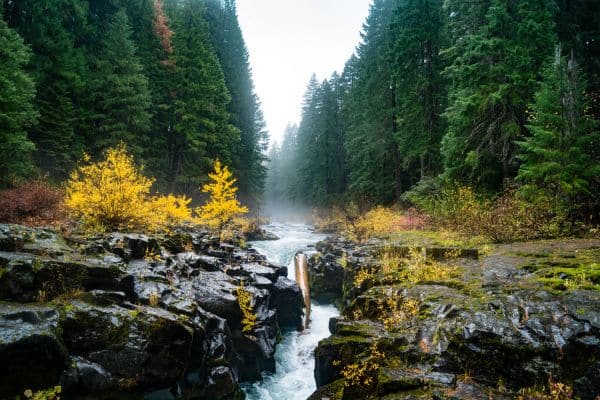
With its expansive trail network, hikers can explore the Siskiyou Mountains, delve into old-growth forests, or tread coastal paths that offer panoramic ocean views.
Campgrounds, ranging from well-equipped to primitive, dot the landscape, making it easy for visitors to immerse themselves in nature overnight.
For those keen on flora, the region’s botanical areas showcase a plethora of unique plant species, making springtime visits especially vibrant with wildflower blooms.
Before setting off, it’s advisable to stop by one of the forest’s visitor centers for updated trail information, permits, and local tips.
Just a short drive from major cities like Medford, Rogue River-Siskiyou provides a convenient yet comprehensive wilderness escape, making it a must-visit for anyone exploring the Pacific Northwest.
Wildlife in Rogue River-Siskiyou National Forest
The Rogue River-Siskiyou National Forest, stretching across Oregon and Northern California, is a hotspot for wildlife enthusiasts. With varied landscapes from coastal terrains to mountainous regions, the forest is teeming with a diverse range of animals.
Among the most commonly spotted are the black-tailed deer and Roosevelt elk, often seen grazing in meadows near water sources. For those seeking a thrill, elusive predators like black bears and cougars also call this forest home, though sightings are rare.
Birdwatchers are in for a treat, with the northern spotted owl and peregrine falcon reigning over the skies. The soft chirps of the marbled murrelet and the songs of the mountain bluebird add melody to forest ambience.
The iconic Rogue River is a hub of aquatic life. River otters play on its banks, and during spawning seasons, areas of the river teem with steelhead trout and Chinook salmon, making their strenuous upstream journey.
The forest floor buzzes with smaller life forms. Reptiles like the western fence lizard and amphibians such as the rough-skinned newt thrive in this rich ecosystem.
For the best wildlife experiences, explore the lower Rogue River region or trek through the Siskiyou Mountain Range.
But remember, always observe from a distance and prioritize the animals’ well-being. In essence, Rogue River-Siskiyou is not just a forest; it’s a vibrant, living ecosystem, offering a unique blend of sights and stories for every visitor.
Hiking Trails in Rogue River-Siskiyou National Forest
With its vast and diverse landscapes, Rogue River-Siskiyou National Forest beckons hikers of all skill levels to explore its terrains.
From serene waterfront paths to challenging mountainous trails, the forest promises a unique experience for everyone. Here’s an exploration of some of its standout hiking routes.
Rogue River Trail: This iconic 40-mile trail follows the meandering path of the Rogue River. Offering both scenic river views and lush forest surroundings, it’s a favorite for multi-day trekkers.
The trail provides glimpses of the river’s rapids and waterfalls, interspersed with quiet wooded stretches.
Boundary Springs Trail: A relatively short, 5-mile round trip hike, this trail takes you to the birthplace of the Rogue River.
The sight of clear water bubbling from the ground at Boundary Springs, especially against the backdrop of the surrounding burn area from previous forest fires, offers a stark and beautiful contrast.
Lower Table Rock Trail: Offering panoramic views of the Rogue Valley, this 5.4-mile round trip hike is moderately challenging.
The flat summit of the Table Rock is home to vernal pools and a unique array of plants, making spring a particularly vibrant time to visit.
Rainbow Trail: A gentle 4-mile round trip, this trail, located near Union Creek, is perfect for families.
Leading to the picturesque Rough Rider Falls, it’s a blend of serene forest walk and the reward of cascading waters.
Eight Dollar Mountain Trail: Nestled in the Illinois Valley, this 3-mile round trip trail is a botanical paradise.
Especially striking in spring and early summer, the trail boasts a rich display of wildflowers, with the surrounding landscapes offering beautiful photo opportunities.
Red Buttes Wilderness Trails: This is more of a network than a singular trail. Located in the Siskiyou Mountains’ heart, the wilderness offers several trail options, with the most popular being the Azalea Lake Trail.
This 10-mile round trip hike is challenging but rewards with views of the pristine Azalea Lake and the surrounding rugged landscapes.
Meyers Creek Beach Coastal Access: For those who prefer the sound of waves to forest silence, this short, 0.5-mile trail offers access to a secluded beach stretch along the Pacific Coast.
The rugged coastline and the chance to spot coastal wildlife make it a unique hiking experience within the forest.
While these trails are some of the highlights, Rogue River-Siskiyou National Forest is crisscrossed with countless other paths, each promising its own set of wonders.
Before embarking on any hike, it’s advisable to check with local ranger stations for trail conditions, potential closures, and any necessary permits.
No matter the trail chosen, the forest offers a sensory delight – from the soft rustle of leaves, the chirping of diverse birdlife, to the fragrance of blooming wildflowers or the crisp mountain air.
It’s not just about reaching the destination but also about immersing oneself in the journey, feeling the pulse of the forest with every step.
Whether a seasoned hiker or a casual trekker, the trails of Rogue River-Siskiyou await, promising memories that will linger long after the hike is over.
Camping in Rogue River-Siskiyou National Forest
Nestled at the crossroads of Oregon and Northern California, Rogue River-Siskiyou National Forest offers an immersive camping experience that’s both rejuvenating and adventurous.
The forest’s vast expanse, characterized by a blend of coastal rainforests, rugged mountains, and serene waterways, makes it a haven for campers seeking diverse experiences.
Begin with the sheer variety of campgrounds available. For those looking for well-established sites with ample amenities, there are numerous options.
Indian Mary Park, for example, located along the banks of the picturesque Rogue River, is not only perfect for pitching a tent but also offers a unique opportunity to camp near historic Native American grounds.
The campground’s proximity to the river also makes it an ideal spot for water activities, from fishing to whitewater rafting.
Union Creek Campground, nestled amidst towering conifers and offering easy access to the crystalline waters of Union Creek, is another popular choice.
With sites suitable for both tent camping and RVs, the sounds of the babbling creek make for a peaceful lullaby each night.
For those inclined towards coastal settings, Lobster Creek Campground is hard to beat. Overlooking a serene stretch of the Rogue River just before it merges with the Pacific Ocean, campers here enjoy both forested tranquility and the rhythmic sounds of crashing waves in the near distance.
If high-altitude settings call out to you, Bolan Lake Campground might be your ideal spot. Located near the crest of the Siskiyou Mountains, this campground is surrounded by dense old-growth forests and sits beside the pristine Bolan Lake.
The elevation and clarity of the atmosphere here also make it a favorite spot for stargazers.
For campers seeking a more secluded experience, dispersed camping offers the perfect solution. Rogue River-Siskiyou National Forest has various regions where campers can set up their tents outside designated campgrounds.
Areas near Briggs Valley or the more remote sections of the Siskiyou Wilderness offer solitude and an unfiltered connection with nature.
While these areas provide an unmatched sense of wilderness, campers should be prepared for minimal amenities and must adhere to Leave No Trace principles to maintain the area’s pristine beauty.
Beyond just the act of camping, the forest’s vastness offers a plethora of activities.
Hiking is, of course, a favorite, with trails like the Rainbow Trail near Union Creek or the coastal paths near Arch Rock Point offering varying levels of difficulty and distinct scenic views.
Many campgrounds, especially those near the Rogue River, are also launch points for rafting or kayaking adventures.
Fishing enthusiasts will find the forest’s waterways teeming with opportunities.
The Rogue River, renowned for its rich biodiversity, is home to salmon and steelhead, and the numerous smaller creeks and lakes throughout the forest also promise rewarding catches.
While the activities and sights are boundless, there are certain practicalities every camper should keep in mind.
First and foremost, the forest’s popularity, especially during summer months, means that reservations are recommended for most established campgrounds.
Checking in with local ranger stations can also provide invaluable insights on campsite availability, current conditions, and any potential wildlife alerts.
Safety, of course, should always be a priority. While the forest’s expansive wilderness is its biggest draw, it’s essential to be prepared for its challenges.
Ensuring you have ample water, understanding the terrain, and being equipped for sudden weather changes can make the difference between a memorable camping experience and a challenging one.
Furthermore, while the chance of encountering a bear or cougar is minimal, understanding how to safely coexist with the forest’s wildlife is crucial.
Umpqua National Forest
Spanning Oregon’s southern Cascade Range, the Umpqua National Forest covers over 980,000 acres, showcasing the Pacific Northwest’s raw beauty.
Its landscapes are a mosaic of ancient volcanic remnants, dense old-growth forests, and shimmering waterways, each telling tales of the region’s rich geologic past.
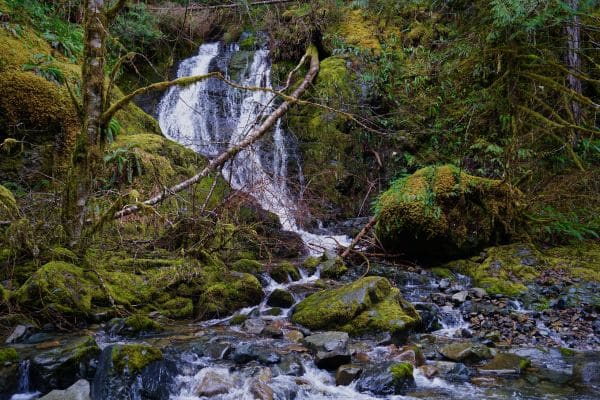
Umpqua’s allure isn’t just its scenic vistas; it’s also a haven for outdoor enthusiasts. The roaring North Umpqua River, renowned for its crystal-clear waters, offers opportunities for whitewater rafting and fishing.
Meanwhile, the forest’s extensive trail system invites hikers to explore cascading waterfalls, serene lakes, and panoramic mountain views.
With a diverse ecosystem, it’s also a wildlife watcher’s paradise, housing species ranging from majestic Roosevelt elk to elusive cougars.
Whether it’s the call of adventure, the serenity of nature, or the allure of uncovering hidden gems, the Umpqua National Forest stands as a testament to nature’s grandeur, beckoning visitors to delve into its wonders.
Wildlife in Umpqua National Forest
Umpqua National Forest is a tapestry of habitats, each supporting a diverse array of wildlife, making it a prime destination for those eager to connect with nature’s inhabitants.
Mammalian life is abundant and varied. Roosevelt elk roam the meadows, their majestic antlers a sight to behold especially during the rutting season.
The dense canopies and underbrush are territories for the black bear and cougar, two of the forest’s apex predators.
While encounters with these creatures are rare and should be approached with caution, their mere presence adds a touch of wildness to the Umpqua experience.
Smaller mammals, such as the gray fox, North American porcupine, and the playful Douglas squirrel, offer delightful sightings for the patient observer.
The avian diversity is equally remarkable. The northern spotted owl, a symbol of old-growth forests, can be heard echoing its calls during dusk.
Raptors like the peregrine falcon and bald eagle soar the skies, their keen eyes scouting for prey.
The riparian zones of the forest, especially along the North Umpqua River, are aflutter with water-associated birds like the dipper and kingfisher.
Umpqua’s waterways, especially its streams and rivers, teem with aquatic life. Steelhead trout and Chinook salmon navigate these waters, especially evident during their spawning runs.
Their presence, in turn, supports a food chain, attracting animals like the river otter and American mink that rely on these fish as a primary food source.
The forest floor and its myriad microhabitats are realms for reptiles and amphibians. Species like the western pond turtle, rough-skinned newt, and the Pacific tree frog thrive in these spaces, often found near the forest’s numerous water bodies.
For those venturing into Umpqua for wildlife watching, dawn and dusk are often the most rewarding times.
Carrying a good pair of binoculars, moving silently, and being patient are keys to a successful wildlife experience.
Always remember to view from a distance, ensuring minimal disturbance to these wild residents.
Hiking Trails in Umpqua National Forest
Umpqua National Forest boasts a vast network of trails, catering to both the casual walker and the seasoned hiker. Here’s a deep dive into some of its most iconic and scenic pathways.
North Umpqua Trail: Stretching over 78 miles alongside the North Umpqua River, this trail is a treasure trove of diverse landscapes. It’s segmented into various shorter sections, allowing hikers to choose according to their comfort.
The trail meanders through old-growth forests, past volcanic crags, and offers numerous vantage points to admire the river’s rapids and cascades.
Mount Thielsen Trail: For those seeking an adrenaline rush, this challenging 9.2-mile round-trip trail promises just that.
Leading to the summit of Mount Thielsen, it offers panoramic views of the Cascade Range.
The final ascent, known as the “lightning rod of the Cascades,” is a scramble that requires care.
Watson Falls Trail: A shorter, 0.6-mile round-trip, this trail is perfect for families and those looking for a relaxed hike.
Leading to Watson Falls, Oregon’s third-highest waterfall, the trail is adorned with ferns and moss, creating a lush green backdrop against the cascading waters.
Toketee Falls Trail: This 0.8-mile round-trip trail leads hikers to a viewing platform where they can admire the two-tiered Toketee Falls.
With basalt columns forming a unique backdrop, the waterfall is one of the forest’s most photographed spots.
Brice Creek Trail: Ideal for those who cherish serene woodland walks, this 5.7-mile trail winds its way alongside Brice Creek.
Numerous smaller cascades and swimming holes make it a favorite during summer months.
Twin Lakes Trail: A moderate 6.4-mile round-trip hike, it takes adventurers through dense forest to two pristine alpine lakes – North and South Twin Lakes.
Surrounded by subalpine meadows bursting with wildflowers in the summer, it’s a picturesque setting for a tranquil escape.
Acker Divide Trail: For a more secluded experience, this 10.4-mile trail is a gem. Traversing ridgelines and offering glimpses of the North Umpqua River, it’s a journey of continuous scenic delights.
Before embarking on any trail, it’s vital to check trail conditions, especially in the shoulder seasons when some paths may be snow-covered or muddy.
Ensure you’re equipped adequately, with maps, water, and appropriate footwear. Remember, every trail in the Umpqua National Forest offers a unique window into the region’s natural splendors, and it’s not just the destination, but the journey that counts.
With each step, hikers can absorb the beauty, tranquility, and sheer magnificence of the Pacific Northwest.
Camping in Umpqua National Forest
The Umpqua National Forest offers a diverse array of camping experiences, making it a favored destination for those wishing to immerse themselves in Oregon’s wilderness.
From fully equipped campgrounds to serene dispersed sites, here’s what campers can expect:
Diamond Lake Campground: Sitting adjacent to the shimmering Diamond Lake, this campground is ideal for those who love waterside camping.
It’s equipped with multiple sites, suitable for both tents and RVs, and boasts amenities such as picnic tables and restrooms.
With fishing, boating, and swimming opportunities right at its doorstep, it’s a hub of activity during the summer months.
Hemlock Lake Campground: Nestled in a dense forest setting, Hemlock Lake offers a more secluded experience.
The sites here are surrounded by towering trees, providing ample shade and that quintessential forest ambiance.
The nearby lake is a tranquil spot for fishing or simply soaking in the serenity.
Poole Creek Campground: Overlooking Lemolo Lake, Poole Creek is another picturesque waterside campground.
It’s particularly popular among anglers, with the lake home to kokanee salmon and rainbow trout.
The campground offers well-maintained sites and is a stone’s throw away from several hiking trails.
Boulder Flat Campground: Located on the banks of the North Umpqua River, this campground is perfect for those keen on river-based activities.
The continuous melody of flowing water, combined with shaded sites and proximity to fishing spots, makes it a sought-after destination.
Toketee Lake Campground: For campers who prefer higher elevations and cooler temperatures, Toketee Lake is a great choice.
Located near the renowned Toketee Falls, it’s not only a peaceful camping spot but also a great base for exploring nearby attractions.
Dispersed Camping: For those who truly want to escape the crowds, Umpqua National Forest permits dispersed camping in many of its areas.
This means you can pitch your tent outside designated campgrounds, often closer to nature’s heartbeat.
While these sites offer unparalleled privacy, campers should be prepared with their own water and be sure to follow Leave No Trace principles.
When planning a camping trip in Umpqua, it’s recommended to check the availability of campgrounds, especially during peak seasons when they tend to fill up quickly.
Some campgrounds operate on a reservation basis, while others are first-come, first-served. Always ensure you’re equipped with the necessary gear, and respect the forest’s rules and guidelines.
Willamette National Forest
Spanning the western slopes of Oregon’s Cascade Range, from Mount Jefferson’s snowy peak down to the Calapooya Mountains, Willamette National Forest covers over 1.6 million acres of diverse and vibrant landscapes.
This vast expanse is a mosaic of dense evergreen forests, sparkling alpine lakes, and cascading waterfalls.
Characterized by its lush old-growth woods, the forest is home to some of the state’s tallest trees, including Douglas firs and Western red cedars.
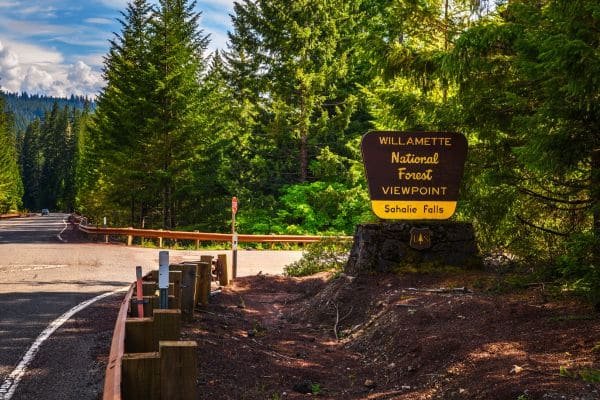
Apart from its natural splendor, Willamette is rich in recreational opportunities. With over 1,500 miles of trails, it beckons hikers, mountain bikers, and equestrians to explore its vast terrains.
The McKenzie and Santiam Rivers carve through the forest, providing pristine settings for fishing, kayaking, and rafting.
For those keen on cultural history, the forest’s ancient lava flows and historic sites offer a glimpse into both the geologic past and early human settlements.
With easily accessible campgrounds, scenic byways, and the promise of both adventure and tranquility, Willamette National Forest is cherished by visitors from near and far.
Wildlife of Willamette National Forest
Willamette National Forest, a vast stretch of pristine wilderness, stands as a sanctuary for a wide array of flora and fauna.
The forest’s varied habitats, from its alpine meadows to dense coniferous woods, support a wealth of biodiversity that accentuates the region’s natural splendor.
Mammals dominate the forest’s landscapes. Majestic Roosevelt elk traverse the meadows, particularly in areas like the Gold Lake Bog.
Their antlered silhouettes, especially during the rutting season, make for awe-inspiring sights. Alongside the elk, black-tailed deer are commonly spotted, often seen grazing or leaping through dense underbrush.
But it’s not just the herbivores that capture attention. Willamette’s dense canopies provide refuge for the black bear and the elusive cougar.
While these apex predators are naturally shy, the thrill of potentially encountering one adds a touch of wild exhilaration to any trek.
The forest’s avian diversity is noteworthy. Skies are frequently patrolled by the northern spotted owl and osprey, while the distinctive call of the pileated woodpecker reverberates through the woods.
Riparian zones, especially along the McKenzie and Santiam Rivers, attract various waterfowl and birds, including dippers, kingfishers, and great blue herons.
Willamette’s waterways brim with aquatic life. Rivers teem with fish species like rainbow trout, Chinook salmon, and steelhead, making them a haven for anglers.
These water bodies also support amphibians such as the western red-legged frog and the rough-skinned newt.
Reptiles, although less commonly spotted, have their niche here too.
The western fence lizard, with its unique push-up display, and the garter snake can occasionally be seen sunning themselves on warm rocks or pathways.
Beyond the larger, more noticeable creatures, the forest plays host to a myriad of smaller beings. Butterflies, like the Oregon swallowtail and monarch, flit between flowers, and various beetles and insects scuttle through the undergrowth, each playing a vital role in the ecosystem.
When exploring Willamette National Forest, visitors should be respectful of its inhabitants.
Keeping a safe distance, especially from larger mammals, and refraining from feeding wildlife are essential practices.
After all, one of the forest’s primary charms lies in observing animals in their natural, undisturbed state.
Hiking Trails in Willamette National Forest
Willamette National Forest’s sprawling landscape, crisscrossed with trails, offers a rich selection for adventurers of all skill levels.
Each path holds the promise of uncovering the forest’s scenic wonders, from cascading waterfalls to panoramic mountaintop views.
Here’s a journey through some of its standout trails.
Three Sisters Wilderness Trails: Perhaps the most iconic area within Willamette, the Three Sisters Wilderness boasts a network of trails exploring the region around the three volcanic peaks, aptly named North, Middle, and South Sister.
The Green Lakes Trail is a popular choice, winding its way through meadows and past serene alpine lakes with the Sisters serving as a majestic backdrop.
Sahalie and Koosah Falls Trail: This relatively short, 2.6-mile loop offers hikers the chance to marvel at two of Oregon’s most captivating waterfalls.
The trail runs alongside the McKenzie River, with each waterfall showcasing the river’s raw power and beauty.
Opal Creek Trail: An enchanting 6.6-mile trail, it leads hikers through ancient old-growth forests to the shimmering Opal Pool.
The remnants of historic mining operations along the path add a touch of the bygone era to the experience.
Iron Mountain Trail: For those seeking panoramic vistas, this 2.4-mile trail is a must.
As it ascends Iron Mountain, hikers are rewarded with views of the Cascades’ significant peaks, and in the summer, the mountain’s meadows burst with a colorful display of wildflowers.
Waldo Lake Trail: Encircling one of the clearest lakes in the world, this 20.2-mile trail is both serene and scenic.
While it can be tackled as a challenging day hike, many choose to spread the journey over multiple days, camping along the lakeshore.
Eagles Rest Trail: A moderately challenging 2.4-mile hike, this trail culminates at a rocky outcrop offering expansive views of the Willamette Valley and the surrounding forests.
It’s particularly stunning during sunset, with the landscape bathed in a golden hue.
Proxy Falls Trail: An easy 1.6-mile loop, this trail is all about the destination.
Proxy Falls, with its multiple cascades tumbling over moss-covered rocks, is a photographer’s dream, capturing the essence of Oregon’s cascading beauty.
Before embarking on any hike in Willamette National Forest, it’s essential to check for current trail conditions and potential closures.
Proper preparation, including carrying a map, adequate water, and wearing appropriate footwear, ensures a safe and enjoyable trek.
Each trail, with its unique charm and challenges, offers an intimate experience of Willamette’s diverse landscapes, inviting hikers to step in, explore, and be enchanted by the Pacific Northwest’s splendors.
Camping in Willamette National Forest
Willamette National Forest, with its expansive landscapes and pristine beauty, offers an array of camping experiences, each allowing visitors to immerse themselves in the heart of Oregon’s wilderness.
Here’s an exploration of the various camping opportunities available:
Detroit Lake Campground: One of the most sought-after campgrounds, Detroit Lake’s shores are a camper’s delight.
With both tent and RV sites available, it provides amenities like picnic areas, fire pits, and restrooms.
The lake itself is a hub for water-based activities, from fishing to paddleboarding, making it a summertime favorite.
McKenzie Bridge Campground: Nestled along the banks of the McKenzie River, this campground offers a tranquil riverside experience.
Its proximity to Sahalie and Koosah Falls means campers are just a short hike away from witnessing the cascades’ splendor.
Whispering Falls Campground: As the name suggests, this site offers the melodious backdrop of nearby cascading waters. Located in a dense forested setting, it’s perfect for those seeking solitude and the soothing sounds of nature.
Breitenbush Campground: Situated near the Breitenbush River, this campground is surrounded by old-growth forests, offering shaded sites ideal for both tents and RVs.
The nearby hot springs add a touch of luxury to the wilderness experience.
Waldo Lake Campground: This site allows campers to wake up to views of one of the clearest lakes in the world.
It’s a haven for kayakers and anglers, with the trail circling the lake being a bonus for hiking enthusiasts.
Lookout Creek Dispersed Camping: For those seeking a more primitive and intimate connection with nature, the areas around Lookout Creek offer dispersed camping opportunities.
Here, away from designated campgrounds, campers can set up their site amidst dense woods, ensuring minimal environmental impact and practicing Leave No Trace principles.
French Pete Campground: Located in the heart of the forest, this campground offers a more secluded experience.
With the babbling French Pete Creek nearby and various hiking trails originating from the site, it’s an adventurer’s basecamp.
When planning a camping trip in Willamette, it’s advisable to reserve spots in advance, especially during peak seasons.
While many campgrounds provide basic amenities, campers should be equipped with essential supplies, especially when opting for dispersed camping.
Siuslaw National Forest
Straddling the mesmerizing Oregon coast and extending inland, the Siuslaw National Forest encompasses a diverse range of ecosystems, making it a unique and captivating destination.
Covering over 630,000 acres, Siuslaw effortlessly blends misty coastal terrains with verdant, dense forests, offering visitors a spectrum of nature’s beauty.
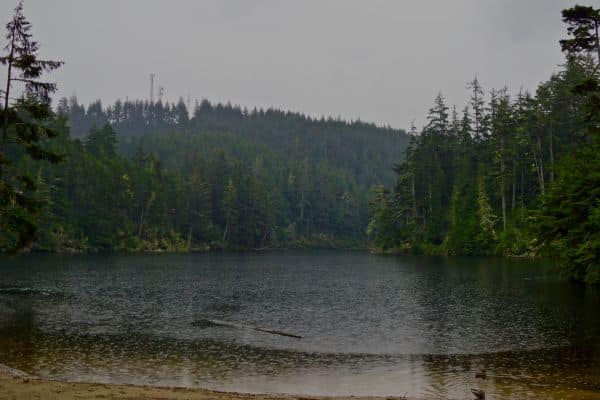
One of the forest’s standout features is the Oregon Dunes National Recreation Area, a vast stretch of shifting sand dunes, some towering up to 500 feet, shaped over millennia by wind and water.
This ever-changing sandy landscape provides a striking contrast to the forest’s western hemlock, Sitka spruce, and Douglas-fir dominated woods.
But it’s not just landscapes that captivate in Siuslaw. The forest boasts a rich cultural history, with indigenous tribes calling these lands home long before European settlers arrived.
Their legacy, combined with remnants of early logging and fishing industries, adds layers of depth to the forest’s narrative.
Whether you’re drawn to the gentle whispers of coastal waves, the tranquil embrace of old-growth forests, or the thrill of dune-buggy rides on expansive sands, Siuslaw National Forest offers it all.
Wildlife in Siuslaw National Forest
The unique blend of coastal and forested ecosystems in Siuslaw National Forest nurtures an exceptional array of wildlife, providing nature enthusiasts with a rich tapestry of observation opportunities.
Mammals: Venturing through the dense canopy of Sitka spruce and Douglas-fir, one might encounter the secretive black-tailed deer, gracefully navigating the undergrowth.
Coastal stretches, particularly around estuaries, might reveal the playful antics of river otters or the graceful silhouette of a Roosevelt elk against the horizon.
The dense thickets also house elusive predators, such as bobcats and coyotes, maintaining the ecosystem’s balance.
Birdlife: The coastal fringes of Siuslaw are a haven for avian enthusiasts.
The haunting calls of the marbled murrelet echo in the forest, while the coastal mudflats attract migratory birds like sandpipers and plovers.
Overhead, majestic bald eagles and ospreys scan the waters for prey, their impressive wingspans casting shadows below.
Amphibians and Reptiles: The forest’s damp environment is ideal for species like the northwestern salamander and the Pacific tree frog.
The Oregon slender salamander, particularly interesting with its worm-like appearance, can also be found hiding under leaf litter or decaying logs.
While reptiles are less common due to the cooler coastal climate, the western garter snake can sometimes be spotted basking in sunnier glades.
Aquatic Life: The freshwater streams flowing through Siuslaw, merging into the Pacific, are vital habitats for several fish species.
Coho salmon and steelhead trout undertake their epic spawning journeys in these waters, providing essential nutrients to the forest and its inhabitants.
Dunes Ecosystem: The Oregon Dunes, a prominent feature of Siuslaw, harbor specialized species adapted to sandy conditions.
Snowy plovers, a bird species of conservation concern, can be seen scuttling across the sands.
Numerous insects, including the vibrant blue butterfly, thrive here, drawing the attention of birds and small mammals.
For those eager to witness the wildlife wonders of Siuslaw, patience and a keen eye are crucial. While some animals might be prominently visible, others remain hidden, revealing themselves only in fleeting moments.
Always remember to maintain a respectful distance and minimize disturbances, allowing these creatures to thrive in their natural habitats.
Hiking Trails in Siuslaw National Forest
Siuslaw National Forest, with its melding of coastal wonders and dense woodland, offers a variety of trails that encapsulate the region’s distinct beauty.
Here’s an immersive look into some of the standout trails that beckon hikers to explore.
Marys Peak Trail: Touted as the highest point within Oregon’s Coast Range, Marys Peak provides panoramic views of both the Pacific Ocean and the Cascade Mountains.
This 6-mile round-trip trail, beginning in a dense conifer forest, gradually unveils meadows bursting with wildflowers during spring and summer.
Oregon Dunes Loop Trail: An iconic trail, this 4.5-mile loop takes hikers on a journey across the undulating Oregon Dunes, giving them an up-close experience of this unique coastal ecosystem.
The trail offers viewpoints that capture the vast expanse of sand, forest, and ocean.
Cummins Creek Trail: Nestled within a designated wilderness area, this 6.5-mile trail is a haven for solitude seekers.
Winding through old-growth forests and showcasing the region’s lush flora, the trail eventually offers views of the rugged coastline.
Hobbit Trail: A magical 1-mile trail that seems straight out of a storybook, this path meanders through dense coastal foliage and opens up to a secluded beach.
The trail, with its moss-covered trees and fern-lined paths, provides a fairy-tale ambiance.
Drift Creek Falls Trail: This 3-mile round-trip trail leads hikers to a striking suspension bridge, offering views of the cascading Drift Creek Falls below.
The trail, lined with ferns and old-growth trees, captures the essence of Oregon’s coastal forests.
Kentucky Falls Trail: A moderate 4.4-mile hike, this trail offers a two-for-one waterfall experience.
Hikers are treated to views of the Upper Kentucky Falls before descending to the twin cascades of the North Fork Smith River.
Sweet Creek Falls Trail: Perfect for families and those seeking a relaxed walk, this 2.2-mile trail offers multiple cascades and waterfalls.
The trail’s accessible boardwalk and viewing platforms make it a popular choice for visitors of all ages.
Before embarking on any hike in Siuslaw National Forest, it’s essential to be equipped with a map, adequate water, and suitable footwear, ensuring a comfortable and enjoyable trek.
Additionally, given the forest’s coastal climate, layered clothing is recommended.
Camping in Siuslaw National Forest
In the embrace of Siuslaw National Forest, camping transcends being merely an activity; it becomes an immersive experience, blending the salty oceanic air with the earthy aroma of the forest floor.
From sand dunes to shaded canopies, here’s a detailed look at the camping opportunities that await within Siuslaw:
Carter Lake Campground: Located near the famed Oregon Dunes, this campground provides direct access to Carter Lake – perfect for trout fishing and canoeing.
With its proximity to the dunes, visitors can enjoy both the tranquility of the lake and the thrill of sand adventures.
Tahkenitch Campground: Positioned amidst thick Douglas firs and hemlocks, this campground offers a serene woodland setting.
It’s a stone’s throw away from Tahkenitch Lake, a hotspot for boating and fishing.
Several trails originate from this area, leading hikers through dunes and to the beach.
Alder Dune Campground: Nestled between Dune and Alder Lakes, campers at this site get the best of both forested and aquatic realms.
The nearby Alder Dune Trail provides an easy hiking route, offering glimpses of local flora and fauna.
Rock Creek Campground: Sitting alongside the shores of the Pacific, this is the perfect spot for beach lovers.
Campsites are shaded with Sitka spruce, and the constant lull of ocean waves ensures a peaceful night’s sleep.
Waxmyrtle Campground: Located near the estuary of the Siltcoos River, this campground provides a unique coastal wetland environment.
It’s a prime spot for bird watching, and the Waxmyrtle Trail leading to the beach passes through diverse habitats.
Marys Peak Campground: For those wanting to camp at higher elevations with panoramic views, this is the ideal choice.
Perched near the summit of Marys Peak, campers here wake up to vistas spanning from the ocean to the Cascades.
Heeler Point Dispersed Camping: For the adventurous soul seeking solitude and a raw connection with nature, the dispersed camping sites near Heeler Point allow campers to set up off the beaten track, devoid of traditional amenities.
When considering a camping trip within Siuslaw, early reservations are advisable, especially during peak seasons when sites fill up swiftly.
Always adhere to the Leave No Trace principles, ensuring the beauty of these sites remains undisturbed for future generations.
Camping in Siuslaw National Forest is a sensory journey, where the rustling of leaves, the crackling of campfires, and the distant call of coastal birds form a harmonious backdrop.
It’s a reminder of nature’s simple joys, beckoning travelers to pause, relish, and reconnect.
Ochoco National Forest
Nestled in the heart of Central Oregon, Ochoco National Forest unveils a distinct side of the state’s diverse landscapes.
Spanning over 850,000 acres, Ochoco is a captivating blend of dense pine forests, rugged high desert terrains, and rolling hills punctuated by ancient volcanic formations.
Unlike its western counterparts characterized by lush rainforests, Ochoco presents a drier, yet equally enchanting, environment.
The forest is dominated by ponderosa pines, which cast long shadows over open meadows and shimmering streams.
These waters, originating from the Ochoco Mountains, breathe life into the arid surroundings, nurturing both flora and fauna.
The region’s volcanic past is evident in its topography, with fascinating geological structures such as the Stein Pillars and the twin peaks of Lookout Mountain.
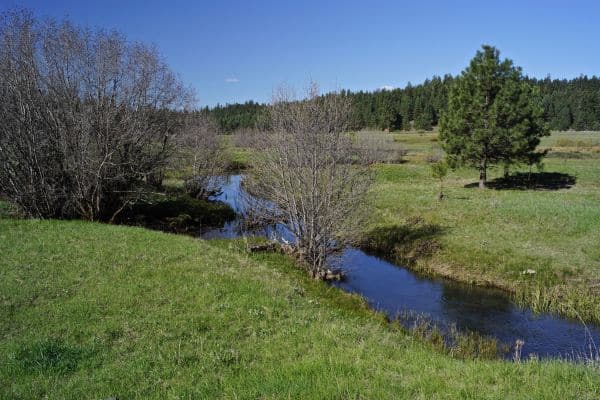
These formations not only offer a window into the earth’s history but also provide panoramic vistas that stretch for miles.
Historically, Ochoco was a significant hub for timber production, and remnants of this industry, along with traces of early ranching and Native American heritage, weave a rich cultural tapestry into the forest’s narrative.
For those seeking an off-the-beaten-path experience, Ochoco National Forest beckons with its promise of solitude and discovery.
Whether it’s hiking through dense woodlands, horseback riding in open pastures, or simply gazing at a starlit sky far from city lights, Ochoco stands as a testament to Oregon’s underrated interior beauty, waiting to enchant its visitors.
Wildlife of Ochoco National Forest
The semi-arid environment of Ochoco National Forest, complemented by its dense pine woodlands and meandering streams, creates a unique habitat, supporting a wide array of wildlife that reflects the region’s distinctive character.
Mammals: As dusk settles over Ochoco, the forest comes alive with the movements of its nocturnal residents.
The mule deer, with its large ears and graceful stance, is a common sight, often seen grazing in open meadows.
Stealthier inhabitants include the bobcat and mountain lion, whose elusive nature makes any sighting a cherished moment.
Burrowing animals, like the badger and yellow-bellied marmot, have adapted perfectly to the rugged terrains, making homes beneath the earth’s surface.
The forest’s waterways and springs are frequented by the North American beaver, whose dam-building activities play a crucial role in shaping the aquatic habitats.
Birdlife: The vast skies above Ochoco are adorned with the graceful flights of various bird species.
Red-tailed hawks and golden eagles soar above, their keen eyes scouting the ground below for prey.
The woodlands echo with the calls of woodpeckers, including the flamboyant Lewis’s woodpecker and the rhythmic northern flicker.
Along the water bodies, dippers and kingfishers dart about, their lives intricately linked with the aquatic realm.
Reptiles and Amphibians: The forest’s warmer pockets provide a haven for reptiles.
The western rattlesnake, while often misunderstood, plays a pivotal role in controlling rodent populations. The agile western fence lizard can often be spotted basking on sunlit rocks.
Ochoco’s wetter regions support amphibians like the western toad and the Columbia spotted frog, whose life stages provide a fascinating insight into the adaptations of desert-dwelling amphibians.
Fish: The streams and creeks of Ochoco, despite their seemingly quiet demeanor, teem with life.
Species like the redband trout, adapted to warmer and variable water temperatures, thrive here, providing both ecological balance and recreational opportunities for anglers.
For visitors keen on experiencing the wildlife wonders of Ochoco, it’s essential to move quietly, maintain a respectful distance, and embrace the unpredictability of nature.
Each creature, from the smallest insect to the most majestic mammal, contributes to the forest’s intricate web of life, reinforcing Ochoco’s standing as a vibrant and diverse ecological haven.
Hiking Trails in Ochoco National Forest
Ochoco National Forest’s unique blend of high desert landscapes and dense woodlands offers an array of trails, each promising a distinct experience of the region’s natural and geological wonders.
Here’s a journey through some of its most notable trails:
Lookout Mountain Trail: One of the forest’s premier hikes, this trail spans roughly 7 miles round trip and leads adventurers to the summit of Lookout Mountain.
As hikers ascend, they’re treated to panoramic vistas, showcasing the Cascade Range to the west and the vast high desert plains to the east.
Round Mountain Trail: An approximately 8-mile round trip, this trail provides an invigorating climb to the peak of Round Mountain.
The journey offers glimpses of the forest’s rich flora, including vibrant wildflower displays during spring and summer.
Steins Pillar Trail: This 4-mile round trip is less about the distance and more about the destination.
The trail culminates at the base of the impressive Steins Pillar, a geological marvel that stands as a testament to the region’s volcanic past.
Twin Pillars Trail: Spanning 8.4 miles round trip, this trail guides hikers through dense forests and meadows, eventually leading to the magnificent Twin Pillars – volcanic rock formations that dominate the landscape.
Barnhouse Campground to Summit Trail: Perfect for those seeking a shorter trek, this 2.5-mile trail offers a gentle climb, with the summit providing sweeping views of the Ochoco Mountains and the Crooked River Valley.
North Fork Crooked River: A serene trail that traces the river’s path, this is an ideal choice for those looking to connect with Ochoco’s aquatic side.
Spanning roughly 9 miles, hikers can enjoy the sounds of flowing water and the chance to spot local wildlife, especially near the water’s edge.
Walton Lake Trail: A relatively easy 2-mile loop, this trail circles the scenic Walton Lake.
With opportunities for birdwatching, picnicking, and simply soaking in the lakeside tranquility, it’s a favorite among families and casual hikers.
Before embarking on any trail in Ochoco National Forest, it’s wise to check for seasonal conditions, as some paths might be snow-covered or muddy, depending on the time of year.
Equipping oneself with a detailed map, ample water, and protective gear ensures a safe and enriching hiking experience.
Every trail in Ochoco serves as a pathway into the heart of Central Oregon’s diverse landscapes, urging hikers to pause, reflect, and marvel at the natural world’s enduring beauty.
Camping in Ochoco National Forest
Within the folds of Ochoco National Forest, camping experiences range from the vast expanses of the high desert to the cool shade of ponderosa pines.
Whether you’re seeking the serenity of a remote site or the comforts of an established campground, Ochoco promises a memorable stay.
Here’s an insight into the camping offerings:
Ochoco Divide Campground: Situated near the summit of Ochoco Divide, this campground offers a refreshing high-elevation retreat.
With both tent and RV sites available, campers are treated to views of the surrounding forest and easy access to nearby hiking trails.
Walton Lake Campground: Nestled on the shores of the picturesque Walton Lake, this site provides a perfect mix of aquatic activities and woodland exploration.
Boating, fishing, and swimming in the lake are popular pastimes, complemented by evening campfires under starlit skies.
Big Summit Prairie: For those looking to truly disconnect, this vast meadow offers dispersed camping opportunities.
The open landscape, especially during spring, bursts with colorful wildflower displays and offers a unique high desert camping experience.
Barnhouse Campground: Located near various trailheads, this campground is a favorite among hikers and equestrians.
Its proximity to key attractions, including Lookout Mountain and Round Mountain, makes it a strategic base for outdoor adventures.
Antelope Flat Reservoir Campground: Overlooking the serene Antelope Flat Reservoir, this site is a haven for anglers and those seeking a waterside retreat.
Its remote location ensures a peaceful stay, punctuated by the gentle sounds of rippling water and nocturnal wildlife.
Wildcat Campground: Set along the Wildcat Creek, this campground provides a riparian setting in the midst of dense woodlands.
The soothing sounds of the creek, combined with shaded sites, make it ideal for relaxation and nature immersion.
Independent Mine Campground: Infused with a touch of history, this site is near the old Independent Mine.
Today, it offers a quiet camping experience, with trails leading to remnants of the region’s mining past.
For those venturing into Ochoco National Forest, it’s essential to note the seasonal availability of certain campgrounds, especially given the region’s variable climate. Reservations, where possible, are recommended during peak seasons.
Moreover, campers should always adhere to fire safety regulations and practice Leave No Trace principles to ensure the environment remains pristine for future generations.
Camping in Ochoco is more than just setting up a tent or RV; it’s about immersing oneself in the diverse landscapes of Central Oregon.
With each sunrise and sunset, the forest unfolds stories of geological wonders, historical legacies, and the simple, profound joys of nature.
12 Essential Tips When Visiting National Forests in Oregon
- Plan Ahead: Before heading out, research the specific forest you plan to visit. Check for any alerts, closures, or restrictions that might be in place.
- Pack Out What You Pack In: Adhere to the “Leave No Trace” principles. Always take your trash with you, leaving campsites and picnic areas as you found them or even cleaner.
- Be Fire-Safe: Oregon’s forests are susceptible to wildfires. If you plan to have a campfire, ensure it’s allowed, use designated fire rings, keep the fire small, and fully extinguish it before leaving.
- Respect Wildlife: Maintain a safe distance from all wildlife. Never feed animals, as it can harm them and alter their natural behaviors.
- Prepare for Varied Weather: Oregon’s climate can be unpredictable. Pack layers, and always be prepared for sudden changes, especially in higher elevations.
- Stay on Marked Trails: To protect delicate ecosystems, always hike on designated paths. Avoid creating new trails or trampling on vegetation.
- Camping Etiquette: If you’re camping, especially in backcountry or dispersed sites, set up camp at least 200 feet away from lakes and streams to protect riparian areas.
- Water Safety: Always treat or boil water from streams or lakes before consumption to avoid waterborne illnesses. When engaging in water activities, wear a life jacket and be aware of water currents.
- Respect Cultural Sites: Some forests in Oregon have historical or indigenous sites. Always observe from a distance, avoiding touching or removing artifacts.
- Be Road Aware: Many national forests have unpaved or gravel roads. Ensure your vehicle is suitable for the terrain, and always let someone know your intended route and expected return.
- Bear in Mind: Some forests in Oregon are home to bears. Store food and scented items in bear-proof containers or hang them from a tree, away from your sleeping area.
- Share the Space: Remember, national forests are for everyone. Whether you’re hiking, biking, or horseback riding, be courteous to other trail users, yielding the path when necessary and minimizing noise.
Exploring Oregon’s national forests is a privilege, offering an unparalleled connection to nature. By following these tips, you ensure not only your safety and enjoyment but also the preservation of these pristine environments for generations to come.
Conclusion
Oregon’s national forests are more than just expanses of trees and trails; they are living testaments to the state’s rich ecological and cultural tapestry.
From the tranquil shores of the Siuslaw to the rugged peaks of the Ochoco, these forests weave stories of ancient landscapes, diverse wildlife, and the timeless bond between humans and nature.
As we traverse their trails, camp under their canopies, and marvel at their wildlife, we’re not just visitors but stewards, entrusted with the care and preservation of these natural wonders.
Whether you’re an avid hiker, a wildlife enthusiast, or someone seeking solace in nature’s embrace, Oregon’s national forests beckon with open arms, promising experiences that resonate deep within, long after the journey ends.
So, pack your bags, respect the land, and let the wild beauty of Oregon’s forests etch memories that last a lifetime.
How many National Forests are in Oregon?
Oregon is home to 11 National Forests: Deschutes, Fremont-Winema, Malheur, Mount Hood, Ochoco, Rogue River-Siskiyou, Siuslaw, Umatilla, Umpqua, Wallowa-Whitman, and Willamette.
What is the most beautiful national forest in Oregon?
Beauty is subjective, and each National Forest in Oregon offers its unique charm. Many consider Mount Hood National Forest, with its iconic peak and diverse landscapes, as one of the most scenic. However, every forest in Oregon has its distinct allure, be it coastal vistas, desert terrains, or dense woodlands.
What is the major forest in Oregon?
While all of Oregon’s National Forests are significant, Mount Hood National Forest is often recognized as one of the most prominent due to its extensive area, diverse ecosystems, and the iconic Mount Hood peak.
Where is the biggest national forest?
In the United States, the Tongass National Forest in Alaska is the largest, spanning approximately 16.7 million acres.
Which US state has the most national forests?
California holds the title for the most National Forests, with a total of 20.
How many National Forests are in Oregon?
Oregon is home to 11 National Forests: Deschutes, Fremont-Winema, Malheur, Mount Hood, Ochoco, Rogue River-Siskiyou, Siuslaw, Umatilla, Umpqua, Wallowa-Whitman, and Willamette.

